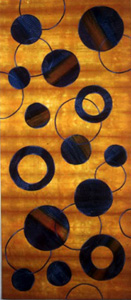![[Metroactive Movies]](/gifs/movies468.gif)
[ Movies Index | Show Times | North Bay | Metroactive Home | Archives ]
Blanket Concept
Bay Area artists do more than just patch art together
By Gretchen Giles
The very nature of the quilt as an object brings up comforting, domestic images. Quilts are used to warm and solace, to ensure succor against cold winter nights. They are crafted to greet a new baby, to embrace a new marriage. They are traditionally made by a group of women, formed together in a "bee," who trade recipes and secrets as they handstitch, cut, iron and sew the blanket together. Like a female barn raising, quilts conjure images of community and country handicraft, smiling women with plump arms and grandmotherly ways, hot back porches and cold iced tea.
But if a quilt is simply defined by what it is--and at the strictest level, it is merely three layers somehow attached together--a wildly free concept of the homely quilt begins to arise. Could it be made with paper rather than fabric, include sculptural elements, be reduced to two attached layers or one layer with no addition? How far can this object be deconstructed before it can no longer bear its name? The quilt, in fact, may never be used to warm, to succor or to greet; it may just be a new and challenging canvas for the artist to work upon.
The collective of 10 Bay Area artists formed under the Fault Line Studios moniker make quilts that break soundly from usual assumptions. East Bay artist Alexandra Von Burg, who began her professional life as a studio assistant to Andy Warhol, likens the work to collage, to building, and resolutely states, "Instead of making a quilt, I make a piece of art." Another collective member, Tiburon film editor Charlotte Grossman, has made a documentary about their efforts, philosophy and surprisingly radical art titled Woman's Work: Making Quilts, Creating Art, showing March 28 and 30 on KQED-TV. While each works alone in her studio, the artists come together regularly to critique each other's work, offer ideas and share information--most of it surrounding the fascinating vagaries of dye.
This is emphatically not a "bee."
By and large, the artists featured in Woman's Work are smiling women with plump arms who look to possess grandmotherly ways, yet who resolutely reject every single element traditional to quilting except, perhaps, a shared passion for fabric. Collective members discuss the sociopolitical side of fabric and its emotional life in all of the folding and washing and sewing and touching that women have historically done. The wistful nature of a fabric scrap assuredly has another allure, one piece from mother's dress being placed here, a scrap from a special gown placed there.
Oakland artist Sue Mary Fox, who describes beginning her career as a "mercenary" seamstress for haute couture and who includes creating costumes for alternative circuses on her résumé, was drawn to quilting in part because she simply can't stand to see waste. Claudia Comay, originally from Columbia, came to the art form when her child was born, laughing now to remember that she thought that an activity involving hot irons, sharp pins and several different types of scissors would be safer around babies. Comay's large, bold abstract quilts are based on nature; the film shows her working on images derived from a group of rocks she found on a recent trip to the Southwest.
While some of the artists bow to the geometric patterning of traditional quilts, Gerrie Peterson, who was born on a San Rafael chicken ranch and trained as a historical architect specializing in refurbishing buildings to exact reproduction, uses the textures--the actual feel and burnish--of old buildings to inform her abstract images. Geneticist Karin Lusnak forms sheer silk squares into three-dimensional masks that she then works into the fabric canvas of each piece, learning in the process to override her scientific bent for exactitude and instead allow accidents to flourish. Marcia Stein makes oversized graphic pieces that conjure painter Alex Katz's distinctive style, and Nina Shortridge creates abstracts that could easily be mistaken for acrylic rather than fabric.
Each shows a flash of intelligent irritation when asked to address whether her work is merely craft. One explains, "The brilliance of our foremothers is that they got to make art that was culturally approved."
Says another shortly, "The question of what is an art quilt is like the question of what art itself is."
[ North Bay | Metroactive Central | Archives ]
Copyright © Metro Publishing Inc. Maintained by Boulevards New Media.
![]()

Sewing Circles: A detail from a quilt by artist Nancy Pagani.
Decide for yourself when 'Woman's Work: Making Quilts, Creating Art' screens on Sunday, March 28, at 5pm and again on Tuesday, March 30, at 1:30pm, on KQED. Check listings for details.
From the March 24-31, 2004 issue of the North Bay Bohemian.